Smart lighting can dramatically cut your energy costs with simple upgrades. Start by evaluating your current setup, then replace old bulbs with efficient LEDs that use 83% less energy. Install motion sensors in high-traffic areas and create custom lighting scenes for different activities. Use geofencing technology, schedule lighting patterns, and monitor consumption through connected apps. Don’t forget outdoor spaces—LED fixtures with smart controls can reduce exterior lighting costs by up to 80%. These smart strategies will transform your home’s efficiency.
Start With a Smart Lighting Ecosystem Assessment
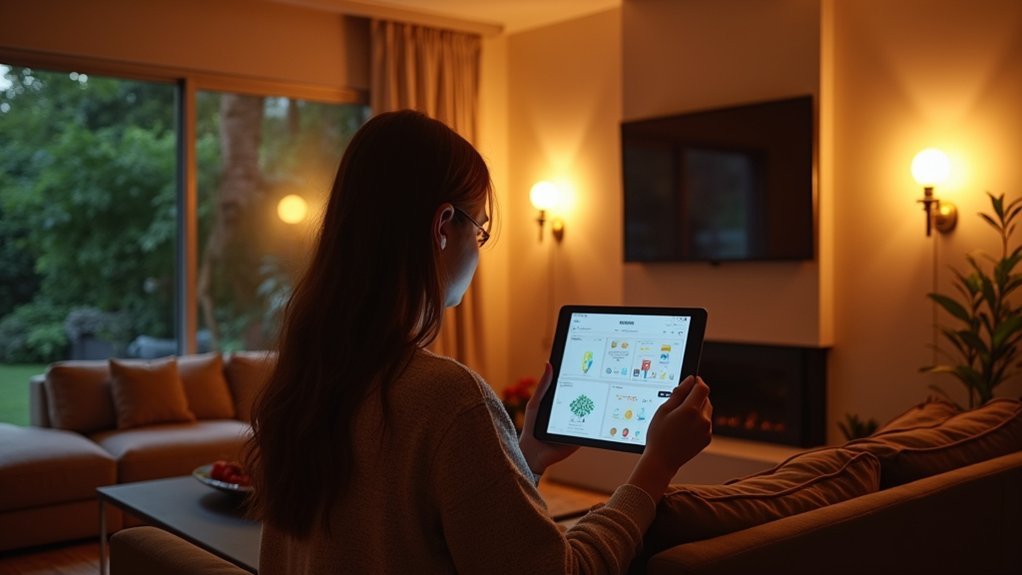
Before diving into smart lighting upgrades, you’ll need to thoroughly evaluate your current lighting setup and home environment.
Begin by inventorying all existing fixtures, noting their types, wattages, and compatibility with smart controls. Identify fixtures requiring replacement versus those that can be upgraded. Consider that switching to LED-based smart lighting can achieve 40-50% energy savings compared to traditional lighting systems.
Assess your home’s network strength and coverage, as smart lighting relies on stable connectivity. Look for Wi-Fi dead zones that might affect performance and verify compatibility with your preferred smart system (Zigbee, Z-Wave, or Wi-Fi).
Review your current energy consumption patterns through utility bills or monitoring devices to establish a baseline. Document when and where lighting is used most frequently to inform automation schedules.
This foundation will help you target high-impact areas where smart controls can maximize energy savings.
Replace Outdated Bulbs With Energy-Efficient Smart LEDS
Upgrading to smart LED bulbs represents the single most impactful change you can make for energy-efficient lighting.
These bulbs consume just 10 watts to produce the same brightness as a 60W incandescent while using 83% less energy daily.
Smart LEDs last up to 25 times longer than incandescent bulbs, reducing replacement frequency and waste. They convert 80-90% of energy into light, compared to traditional bulbs’ poor efficiency. LED bulbs have dramatically changed the lighting landscape, growing from just 6.7% of installations in 2015 to nearly half of all residential lighting by 2020.
Modern smart LEDs transform 80-90% of energy into light while outlasting incandescent bulbs 25x longer, dramatically reducing waste.
For maximum savings, start by replacing high-use area bulbs first. Choose ENERGY STAR-certified options, and utilize dimming features when full brightness isn’t necessary.
Set schedules to automatically turn lights off during daylight hours or when rooms are unoccupied. The initial investment quickly pays off through reduced energy bills and fewer replacements.
Harness Motion Sensors for Automatic Light Management
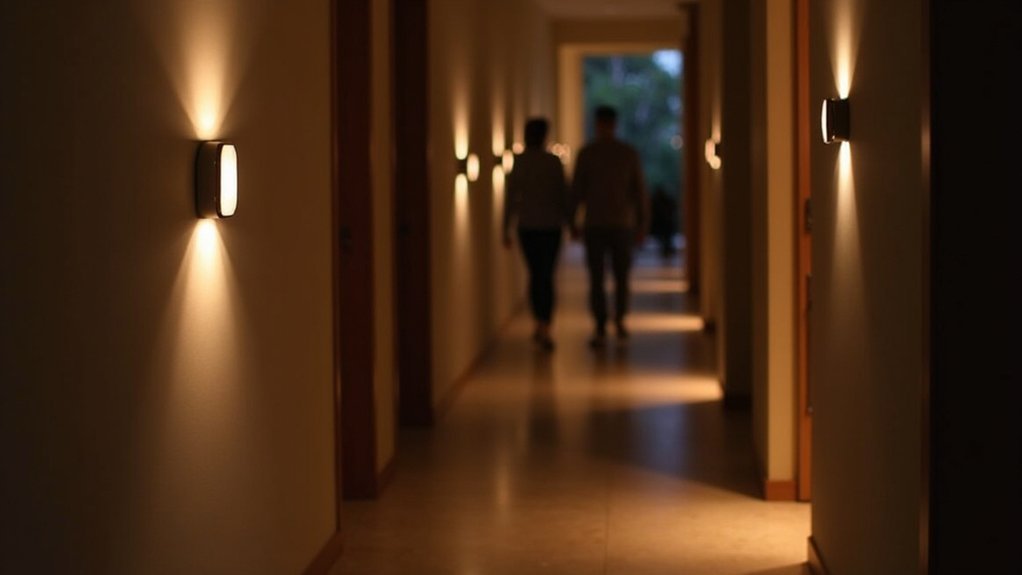
Position your bathroom motion sensors near entry points to activate lights immediately upon entering while keeping them away from shower areas to prevent false triggers from steam.
Install hallway sensors at both ends to guarantee complete coverage and maximize energy savings by eliminating wasted illumination in these changing spaces.
You’ll achieve ideal energy efficiency by adjusting sensitivity settings based on your household traffic patterns, making sure lights activate when needed but don’t stay on unnecessarily. Smart lighting systems integrate these motion-activated features with automatic shut-off capabilities to prevent energy wastage when spaces become unoccupied.
Bathroom Smart Sensor Placement
Where you place motion sensors in your bathroom can make or break your smart lighting experience. Mount sensors between 6-8 feet high, ideally in corners for maximum coverage with a panoramic view of the space.
Position sensors just inside the doorway to detect entry immediately, but keep them away from windows to prevent false triggers from sunlight. For discreet installation, consider placing sensors behind mirrors while maintaining effective coverage. Avoid placing sensors near heat sources like vents or radiators as these can trigger false alarms in your bathroom.
Choose wire-free sensors with appropriate IP20 ratings for bathroom environments. These offer flexible mounting options and easy repositioning with magnetic mounts.
When integrating with your smart home system, verify compatibility for seamless automation.
Remember to calibrate your sensors properly and pair them with energy-efficient LED lighting for peak performance and maximum energy savings.
Hallway Energy Optimization
Transforming your hallway’s energy profile starts with strategic motion sensor placement. Install sensors at entrances and key points to eliminate blind spots, avoiding windows and heat sources that trigger false activations.
For L-shaped or long hallways, use multiple sensors to maintain consistent coverage.
Motion-activated lighting reduces your home’s energy consumption by operating only when needed, potentially cutting lighting costs while extending bulb lifespan. The technology enhances safety by illuminating dark passages and deterring intruders.
Consider pairing sensors with dimmable LEDs or smart strips for creative “runway” lighting effects. You’ll not only save energy but also enjoy the convenience of hands-free operation.
Ultrasonic sensors can be an excellent addition to your hallway system since they can detect slow movements that might be missed by standard sensors.
With the motion sensor market growing steadily and government incentives available, now’s the perfect time to upgrade your hallway lighting system.
Create Energy-Saving Lighting Scenes for Different Activities
Why settle for static lighting when you can create customized scenes that enhance your living experience while reducing energy consumption?
Design morning scenes that gradually brighten lights in essential areas while keeping others off. For dinner, focus illumination on the dining table while dimming surrounding spaces to create intimacy.
When watching movies, turn off lights around the TV, keeping only minimal navigation lighting. Party scenes should highlight food areas while maintaining conversational brightness elsewhere.
Use your system’s vacation mode to simulate occupancy with unpredictable patterns when you’re away. Setting up a reading scene allows you to illuminate specific areas while conserving energy by turning off unnecessary lights.
Set brightness to the minimum comfortable level and activate only necessary zones for each activity. Automate scenes based on your routine to prevent lights from staying on needlessly.
With platforms like Control 4, you’ll save energy while creating the perfect ambiance for every moment.
Implement Daylight Harvesting to Maximize Natural Light
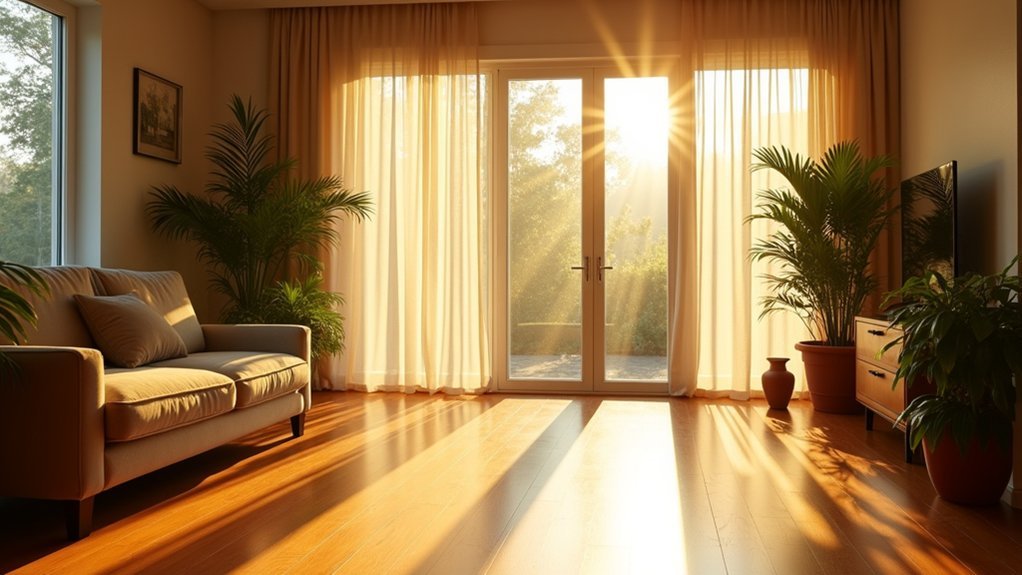
One of the most overlooked energy-saving strategies is right outside your windows. Daylight harvesting uses photocell sensors to detect natural light levels and automatically adjust your artificial lighting accordingly.
By installing this technology, you’ll reduce lighting energy consumption by 25-50%. One case study showed energy use dropping from 4,211 kWh/year to just 1,941 kWh/year—a 54% reduction in your utility bills.
You’ll need strategically placed light sensors that communicate with your lighting controllers. Pair this system with LED fixtures for maximum efficiency. This setup works best in spaces with significant natural light from windows or skylights.
Beyond savings, you’ll create a more comfortable environment with consistent lighting that reduces eye strain and improves ambiance.
This approach not only lowers your carbon footprint but also helps you achieve net-zero goals while maintaining ideal indoor light levels.
Use Geofencing to Prevent Wasted Energy When Away
Geofencing technology can automatically welcome you home by turning on your lights as you approach your house, while ensuring they’re off when you’re away.
You’ll maximize your energy savings with distance-based power management that adjusts lighting based on how far you’re from home.
Create zone-specific energy controls that allow different lighting responses for various areas of your home, giving you precise control over which lights activate when you enter different proximity boundaries.
These smart features can contribute to reducing lighting costs by 35% to 70% when implemented as part of a comprehensive smart lighting system.
Automatic Welcome Home Lights
Walking into a perfectly lit home without flipping a single switch isn’t just convenient—it’s now an energy-efficient reality. Geofencing technology connects your smartphone’s location data to your smart lighting system, automatically turning lights on as you approach and off when you leave. Modern smart lighting systems employ rule-based algorithms to effectively reduce energy consumption while maintaining optimal illumination levels.
| Feature | Benefit | Energy Impact |
|---|---|---|
| Geofencing | Lights activate only when needed | Up to 50% reduction in energy use |
| Smart Home Integration | Coordinated control with other devices | Optimized whole-home efficiency |
| Daylight Sensors | Adjusts based on natural light | Minimizes unnecessary artificial lighting |
You’ll save greatly by combining geofencing with LED bulbs, potentially cutting lighting energy costs by over 60%. Beyond convenience, this technology enhances security by creating the appearance of occupancy while ensuring you’re never wasting electricity on empty rooms.
Distance-based Power Management
Modern households can dramatically reduce energy waste through distance-based power management—a smart extension of geofencing technology that responds to how far you’re from home.
By creating virtual boundaries around your property, your lighting system automatically adjusts when you cross these thresholds. This technology can cut energy consumption by up to 50% in indoor environments, with AIoT-integrated systems achieving 80% higher savings than traditional setups.
When you leave home, lights turn off automatically—no more wondering if you’ve left them on. For maximum efficiency, pair geofencing with motion and daylight sensors.
Select ENERGY STAR certified products and customize geofence boundaries through your smartphone app to match your routines. This approach is similar to warehouse implementations where smart lighting systems have achieved up to 87% reduction in energy consumption compared to conventional lighting. This layered approach guarantees lights operate only when necessary, greatly reducing your energy footprint.
Zone-specific Energy Controls
Taking your smart lighting system to the next level means implementing zone-specific energy controls that target wasted energy with precision.
With geofencing technology, you’ll create virtual boundaries that trigger automatic lighting adjustments as you move between areas of your home.
Program your system to activate lights only in occupied rooms by combining geofencing with motion sensors. This powerful duo guarantees lights turn on when you enter a space and switch off when you leave.
You can customize settings for different zones—hallways might brighten briefly as you pass through, while living areas maintain comfortable lighting during use.
This targeted approach prevents whole-home illumination when unnecessary, delivering energy savings of 16-70% depending on your occupancy patterns.
You’ll never again waste electricity lighting empty rooms while you’re away.
Smart lighting systems integrated with virtual assistants like Google Assistant, Amazon Alexa, or Apple Siri can enhance your zone-specific controls through convenient voice commands.
Schedule Lighting Patterns to Match Your Daily Routine
When you align your home’s lighting with your natural daily rhythm, you’ll save energy while enhancing your comfort and productivity.
Create customized schedules that mirror your daily activities—bright, cool lighting during work hours and warmer, dimmer tones for evenings.
Group lights by room or function, then program them to follow your routine. Set morning lights to gradually brighten, mimicking sunrise to naturally wake you.
Schedule lights to automatically turn off during periods you’re typically away, preventing wasted energy. Setting up smart lighting can lead to energy savings of up to 30% when properly scheduled according to your habits.
For ideal health benefits, implement circadian lighting that shifts from energizing blue tones during daytime to relaxing amber hues at night.
Most smart lighting apps make these schedules easy to set up and adjust as your routines change throughout the week.
Monitor and Analyze Your Lighting Energy Consumption
You’ll gain valuable insights by tracking your lighting’s real-time energy consumption through connected sensors and mobile apps.
Setting specific consumption thresholds prevents wasteful usage by alerting you when lights exceed your predetermined limits.
These monitoring tools visualize your lighting patterns through user-friendly graphs, making it easier to identify opportunities for further energy savings. Smart lighting controls operate on an input/output basis, processing data from sensors to adjust lighting outputs efficiently.
Real-time Usage Insights
Understanding your lighting energy consumption patterns can transform how you manage your home’s energy usage.
With smart lighting systems that provide real-time data, you’ll quickly identify wasteful behaviors and make immediate adjustments. Users save an average of 8% on their electric bill with Sense monitoring systems, giving you valuable insights to optimize your home’s efficiency. These insights enable you to optimize lighting schedules based on actual occupancy patterns, potentially saving 35-70% on lighting energy costs.
- Install IoT-enabled monitoring systems that offer continuous data on energy use, allowing you to track consumption through user-friendly smartphone apps.
- Set up automated controls that react to environmental triggers without manual intervention, adjusting brightness based on available daylight.
- Integrate your lighting data with broader home management systems to create a unified approach to energy efficiency across lighting, HVAC, and appliances.
Set Consumption Limits
Taking control of your energy consumption goes beyond monitoring—it requires setting clear boundaries. Establish specific limits for each lighting zone based on your baseline usage data to prevent energy waste.
Use historical consumption patterns to determine realistic reduction goals. Then implement alert systems that notify you when lighting exceeds these thresholds, prompting immediate action. Your consumption limits shouldn’t remain static—update them regularly to account for seasonal changes and shifting occupancy patterns.
Combine automated scheduling with your established thresholds to keep lighting within your energy budget. This approach guarantees your system maintains efficiency even during your absence. Leverage built-in analytics tools to identify potential energy inefficiencies in your lighting system in real-time.
For maximum effectiveness, pair these limits with vacancy sensors that require manual activation but turn off automatically, delivering greater savings than standard occupancy sensors alone.
Integrate Smart Lighting With Other Home Automation Systems
While smart lighting systems offer impressive standalone benefits, their true potential emerges when integrated with other home automation systems. By connecting your lights with security, HVAC, and entertainment systems, you’ll maximize energy efficiency while enhancing convenience and safety.
- Security integration allows lights to activate when motion is detected or alarms are triggered, deterring intruders while providing necessary illumination only when needed.
- HVAC coordination creates energy-saving scenes that simultaneously adjust lighting and temperature based on occupancy, time of day, or specific activities.
- Entertainment synchronization enables automated “movie mode” or music-responsive lighting that dims appropriately during media playback and brightens when paused.
Using unified control platforms or voice assistants like Alexa or Google Assistant lets you manage these integrated systems effortlessly, reducing energy waste from forgotten devices. Lutron systems like HomeWorks provide bespoke integration capabilities that seamlessly connect with various smart home products for a comprehensive control experience.
Optimize Outdoor Lighting With Smart Controls and Timers
Outdoor lighting presents a significant opportunity for energy optimization, extending the smart home revolution beyond your interior spaces. By switching to LED fixtures, you’ll immediately cut energy use by up to 80% compared to traditional lighting technologies.
Maximize these savings by implementing smart controls that adjust lighting based on real-time conditions. Motion sensors and timers guarantee lights operate only when needed, while smart zoning lets you illuminate specific areas independently. This targeted approach can reduce outdoor lighting energy consumption by 35-70%. Similar to municipal applications, homeowners can achieve up to 70% power savings when converting outdoor lighting to smart LED systems.
For best results, create lighting zones focusing on entry points and pathways while dimming less critical areas.
These systems not only lower your utility bills but also extend fixture lifespan, reduce maintenance costs, and contribute to environmental sustainability—all while maintaining effective security lighting around your home.
Frequently Asked Questions
Do Smart Bulbs Work With Existing Dimmer Switches?
No, you shouldn’t use smart bulbs with existing dimmer switches. They’re incompatible because traditional dimmers interfere with smart bulbs’ microchips, causing flickering and potential damage. Use smart switches instead to control your smart bulbs properly.
How Secure Are Smart Lighting Systems Against Hacking?
Smart lighting systems face significant vulnerabilities, especially through ZigBee protocol flaws like CVE-2020-6007. You’ll need regular firmware updates, strong network security, and device isolation to protect against hackers who can use your lights as network entry points.
Can Smart Lighting Still Function During Internet Outages?
Yes, some smart lighting can function during internet outages. You’ll retain basic control through physical switches and local network connections, especially with Z-Wave or Zigbee protocols. However, you’ll lose remote app control and advanced automation features.
What’s the Typical Payback Period for Smart Lighting Investments?
You’ll typically see payback periods of 6-18 months for smart lighting investments. Your specific timeline depends on your installation costs, energy rates, usage patterns, and available rebates. Many homeowners achieve full returns within 2 years.
How Do Smart Bulbs Compare to Smart Switches for Efficiency?
Smart switches are typically more energy-efficient than smart bulbs when controlling multiple lights. You’ll save more electricity using one switch with standard LED bulbs than individual smart bulbs that constantly draw standby power.
In Summary
By embracing these smart lighting strategies, you’ll dramatically reduce your energy bills while creating a more comfortable, convenient home environment. Don’t wait to transform your lighting system—start with small changes and gradually expand as you see the benefits. The technology’s never been more accessible, and your investment will pay off through long-term savings and enhanced living spaces. Smart lighting isn’t just efficient—it’s simply smarter living.

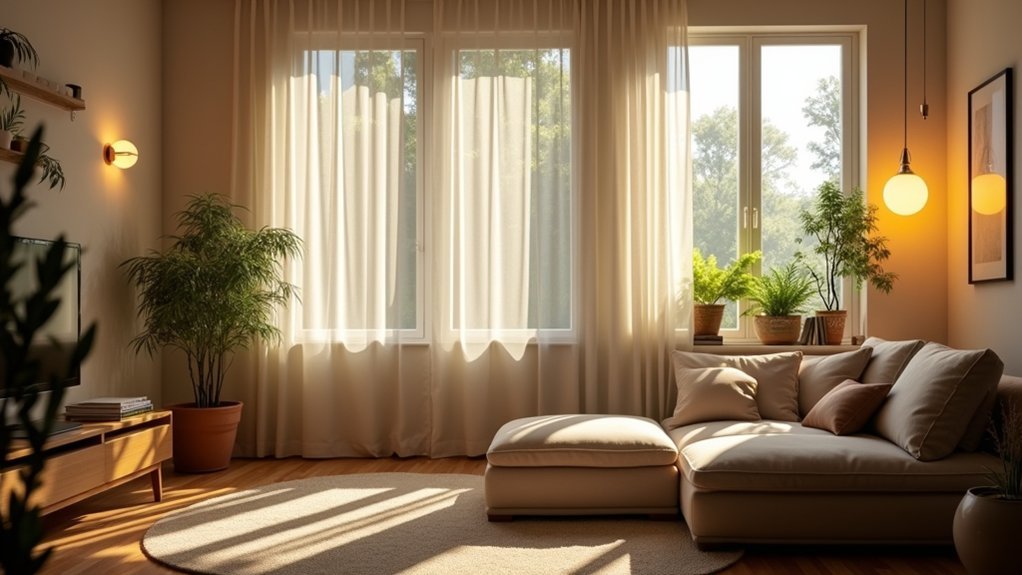


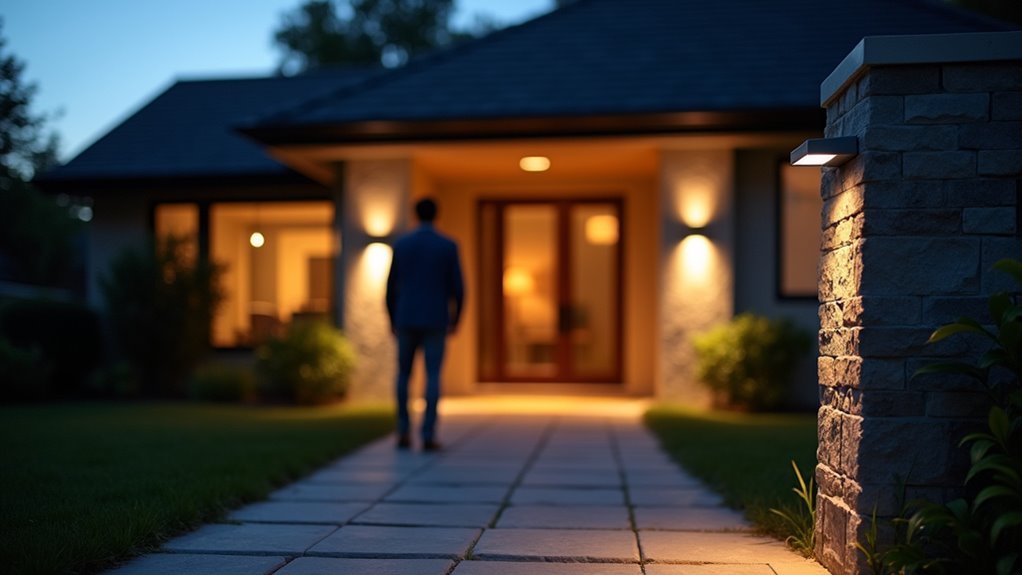
Leave a Reply